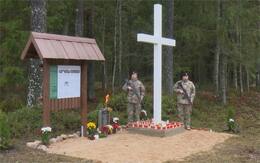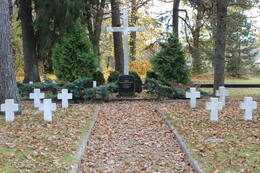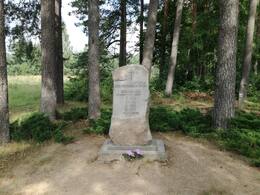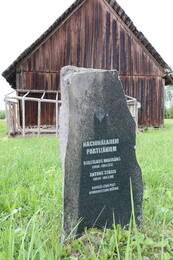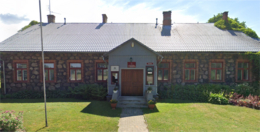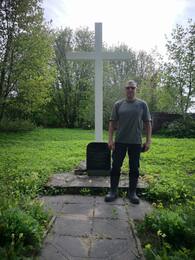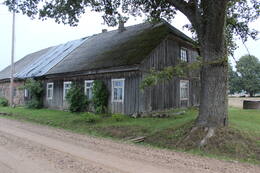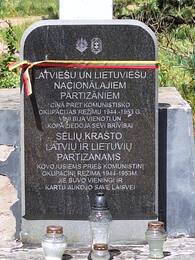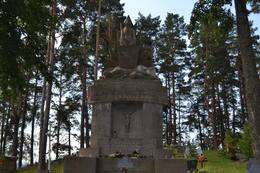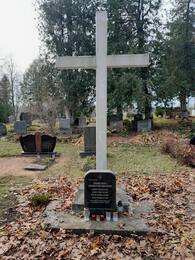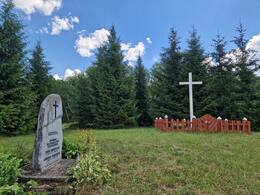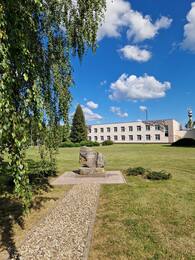Ginkluotas pasipriešinimas sovietų okupacijai Sėloje
P. Praulinio nacionalinio partizanų būrio narių atminimo vieta ir bunkerio vieta
Pēteris Prauliņš (1911–1949) Biržų parapijos nacionalinis partizanų būrelis priklausė Mārtiņa Pokļevinskio (1902–1951) vadovaujamai grupei. Grupė vykdė keletą partizaninių akcijų, kurių metu buvo baudžiami sovietų kolaborantai, rekvizuojamas okupacinės valdžios ekonominių įstaigų maistas ir turtas. P. Praulinio grupės partizanai nesilaikė pakankamo sąmokslo principo, daugelis asmenų lankydavosi jų gyvenvietėje, o tai sudarė sąlygas išdavystei. Karinės patirties stoka buvo vienas iš partizaninio ginkluoto judėjimo trūkumų.
P. Praulinio partizanų grupė Kalnos miške Biržų valsčiuje buvo sunaikinta 1949 m. gegužės 16 d. Latvijos SSR Valstybės saugumo ministerijos operacijos, kurioje dalyvavo ir kariniai daliniai, metu. Miško broliai buvo įsirengę gerai užmaskuotą bunkerį su perimetro gynyba, kuris buvo įsikūręs nenustatytame aukštyje pelkėtoje vietovėje. Partizanai mažiausiai 40 minučių įnirtingai priešinosi Čekos kariuomenei, tačiau krito visa grupė: Pēteris Prauliņš, Artūras Bružukas, Jānis Kalvāns, Edvīns Slikšāns ir Francis Skromanis. Sušaudyti miško broliai buvo numesti netoli valsčiaus namų, tačiau jų palaikai vėliau buvo palaidoti netoliese esančiuose žvyrduobėse. Sunkiai sužeista buvo Irma Bružuka, kuri buvo paimta į nelaisvę ir mirė gegužės 17 d. Jekabpilio ligoninėje. Ji buvo palaidota už kapinių ribų, tačiau, kai kapinės buvo išplėstos po Latvijos nepriklausomybės atkūrimo, ant jos kapo buvo pastatytas paminklas.
1998 m. lapkritį buvo pašventintas atminimo akmuo P. Praulinio grupės partizanams Kalnos valsčiuje. P. Praulinio bunkerio vieta yra Vidsalos 99-ojo kvartalo 4 sekcijoje, Kalnos valsčiuje. Akmuo, ant kurio sėdėjo P. Praulinis, yra išsaugotas.
J. Indānso, J. Grāvelsono ir M. Pokļevinskio nacionalinių partizanų grupių narių atminimo vieta
Lačplėsio dieną – 2019 m. lapkričio 11 d. – buvo atidarytas Indano-Grāvelsono nacionalinių partizanų grupės informacinis stendas ir atminimo vieta Kalnos valsčiuje, Jekabpilio rajone, Sūpės purvo apylinkėse. Jo atidaryme dalyvavo Jekabpilio ir Viesytės regionų atstovai, buvęs nacionalinis partizanas H. Miezīte, istorikas H. Bruņinieks, taip pat svečiai iš Lietuvos ir kiti susidomėję asmenys. Atminimo vieta ir stendas yra netoli Sūpės purvo, kuris siejamas su nacionalinių partizanų gyvenviečių ir mūšių vietomis. Giliau miške taip pat buvo Indano-Grāvelsono grupės bunkeris.
Po Latvijos gyventojų deportacijų 1949 m. kovo 25 d. buvo sunaikinta nacionalinių partizanų aprūpinimo sistema. Nuo 1949 m. vasaros iki 1952 m. vidurio nacionalinis partizanų judėjimas Aknystės, Saukos, Elkšnių, Biržų ir Viesytės apylinkėse išgyveno nuosmukį, nes kentėjo nuo etninio valymo ir reguliarių sovietų armijos bei saugumo institucijų kontrpuolimų. Janio Indano ir Janio Grāvelsono nacionalinių partizanų grupės įsikūrimas Elkšnių miške 1949–1950 m. žiemą turėjo labai rimtą, tuo metu nebūdingą gynybos sistemą, kurios 1950-aisiais nebuvo niekur kitur Latvijoje ar kaimyninėje šalyje Lietuvoje. Indano-Grāvelsono grupės bunkeryje buvo specialiai sukurti perimetro gynybos apkasai ir patrankų lizdai. Greta partizanų karinio pasirengimo paaukoti savo gyvybes kovoje su priešu, galima kalbėti ir apie jų ypatingą tapatybę, kuri pasireiškė ir kitų šeimos narių įsitraukimu į nacionalinių partizanų gretas.
Jungtinę Indano-Grāvelsonų partizanų grupę sudarė 12 žmonių, tarp kurių buvo penkios moterys ir vienas Lietuvos partizanas: Jānis Indāns, Jānis Edvards Grāvelsons, Alma Grāvelsone, Pēteris Indāns, Kristīne Indāne, Milda Ārija Indāne, Vasilijs Sokolovs, Voldemārs Otto Sātnieks, Jonda Sātnieks, Jānis Ķepiņš. Žukauskis. Paskutinis jų mūšis įvyko 1950 metų vasario 25 dieną Elkšnių girioje, kai mūšyje su neproporcingai stipriomis jėgomis krito 11 partizanų. Išgyveno tik Hilda Vietniece (Miezīte), kuri buvo sugauta ir vėliau šešerius metus praleido kalėjime Gulago lageriuose.
Atminimo vieta 1945 m. vasario 13 d. nacionalinių partizanų mūšio vietoje Kalnos parapijos Deimantų miške
Memorialinė vieta buvo sukurta rajoniniame kelyje P74 Siliņi – Aknīste, 12 kilometrų nuo Aknīstės, pasukus į Latvijos valstybinį mišką „Žagari kelias“.
Jau 1944 m. vasaros pabaigoje didžiulis Elkškių valsčiaus šiaurinės dalies miškų masyvas tapo žmonių, besiruošiančių ginkluotai kovai su sovietų okupacine valdžia, susibūrimo vieta. 1944 m. pabaigoje Aknystės apylinkėse pradėjo kurtis nacionalinių partizanų grupės. Tinkama vieta partizanų stovyklai įkurti buvo Deimantinis miškas , esantis Elkškių didžiojo miško pietiniame pakraštyje, netoli Aknystės Didžiosios pelkės. Ten, mažiau nei 10 kilometrų nuo Aknystės valsčiaus, nacionaliniai partizanai įrengė tris žiemos bunkerius žiemojimui. Miške susirinkusių vyrų susisiekimas buvo užtikrinamas padedant netoliese esančių namų – Baltimorės, Gargrodžių, Lyčių, Priedžių, Krūmų – ir kitų namų gyventojams, kaimynams bei partizanams.
Partizanų mūšis su Latvijos SSR Valstybės saugumo ministerijos kareiviais Deimantų miške įvyko 1945 m. vasario 13 d. Čekistai, paėmę įkaitus, juos nustūmė į priekį, kad atidengtų partizanų bunkerius. Miško broliai, pamatę pavojų, atidengė ugnį, negailėdami įkaitų. Mūšyje žuvo 10 sovietų okupacinių kariuomenės atstovų, aštuoni nacionaliniai partizanai ir keturi įkaitai. Nepaisant miško brolių nuostolių, čekistams nepavyko užimti partizanų bunkerių. Išlikę partizanai palaukė sutemų ir paliko gyvenvietę. Mūšyje sužeisti čekistų kareiviai, dejuodami, negalėjo palikti mūšio lauko. Po šio mūšio, kurį galima laikyti pirmuoju miško brolių „kovos krikštu“, partizanai jautėsi kaip broliai, o šautuvas atrodė brangesnis už viską, kaip vienintelis patikimas gelbėtojas.
Baltasis kryžius ir informacinis stendas Deimantų miške buvo įrengti Lačplėsio dieną – 2022 m. lapkričio 11 d. Atminimo vietos sukūrimą parėmė Jekabpilio regioninė valdžia, asociacija „Tēvzemes sargi“ ir Latvijos valstybiniai miškai. Informacinio stendo turinio autorius yra istorikas Haraldas Bruņinieksas.
Sėlijos nacionalinių partizanų brolių kapinės
Sėlijos nacionalinių partizanų brolių kapinės buvo atidarytos 2004 m. spalio 30 d., remiant Latvijos gynybos ministerijai ir Aknīstės savivaldybei. Jose palaidoti 1949 m. gruodžio 19 d. mūšyje Kalnos parapijos Dimantų miške žuvę partizanai: Albertas Karankevičius (1914–1949), Vilis Tunkelsas (1911–1949), Arnoldas Tunkelsas (1926–1949), Osvaldas Tunkelsas (1929–1949), Ēvaldas Kundzanas (1927–1949).
2005 m. čia buvo perlaidoti ir 1945 m. vasario 13 d. mūšyje Elkšnių girioje kritę partizanai: Juris Alfreds Voldemārs Lācis (1908-1945), Eduards Kaminskis (1910-1945), Albertas Mežaraups (1945 m. Alberts Mežaraups, 1945 m. (1915-1945), Antons Bružiks (1911-1945), Jānis Britāns (1926-1945) ir vienas nežinomas. Bendrosiose kapinėse taip pat yra sovietų okupacinės valdžios įkaitais paimtų ir mūšio metu žuvusių Martos Mežaraupės (1907–1945), Alberto Lācio (1902–1945), Jurio Resnīčio (1901–1945) ir Pēterio Bitės (1907–1945) palaikai, taip pat žuvusio Indano-Grāvelsono grupės partizano Voldemaro Otto Sātniekas (1911–1950). Aknīstės brolių kapinėse taip pat yra paminklas Aknīstės kuopos nacionaliniam partizanui Alfredui Silaraupui (1925–1946), žuvusiam per Čekos operaciją 1946 m. liepos 30 d. siaurajame geležinkelyje Elkšnių miške.
Sėlijos nacionalinių partizanų brolių kapinėse pastatyto Baltojo kryžiaus papėdėje stovi juodo granito stela su Latvijos nacionalinių partizanų asociacijos emblema ir po ja iškaltu tekstu „Sėlijos nacionaliniams partizanams. Jūs paaukojote savo gyvybes už Latviją kovoje su komunistiniu okupaciniu režimu 1944–1954 m.“ Kapinėse taip pat yra paminklinis akmuo su užrašu „Yra ašarų, kurios bus išlietos tyloje. Yra randų, kurie neužgis užgijus“, kurį Stanislava Šadurska pastatė Atgimimo pradžioje netoli duobės, kurioje čekistai palaidojo dieną prieš tai, 1955 m. vasario 14 d., žuvusius nacionalinius partizanus ir įkaitus.
Buvę Susėjos parapijos namai, nacionalinių partizanų išpuolio vieta 1945 m. liepos 7 d.
Šiandien buvusiuose Susėjos parapijos namuose įsikūręs Sanssouci rezidencijų centras. Pastato fasade vis dar matyti nacionalinių partizanų kulkų palikti pėdsakai 1945 m. liepos 7 d. puolimo metu.
Buvę Susėjos parapijos namai, tuo metu veikę kaip sovietų okupacinės valdžios vietinis vykdomasis komitetas, 1945 m. liepos 7 d. nukentėjo nuo Sėlijos nacionalinių partizanų išpuolio. Išpuolis prieš Susėjos vykdomąjį komitetą buvo platesnės nacionalinių partizanų kampanijos dalis ir vyko tuo pačiu metu kaip ir išpuoliai prieš Vilkupės sviesto fabriką bei naikintojo Kaunacko namą.
Susėjos nacionalinių partizanų grupės vado Alberto Kaminskio (1920–1946) nurodymu miško broliai turėjo sunaikinti vietos vykdomojo komiteto apsaugą, paimti ginklus, milicijos uniformas, dokumentus ir sugadinti telefono ryšį. Susėjos vykdomojo komiteto puolime dalyvavo apie 17 miško brolių, vadovaujamų Lietuvos partizanų vado Jozo Kuveikio. Mūšis truko 15–20 minučių, susišaudymo metu žuvo vienas Lietuvos partizanas, o kitoje pusėje – naikintojų bataliono Jānio Kakarano kovotojas. Susišaudymo metu buvo išdaužti vykdomojo komiteto langai ir apgadintas telefonas.
Antrasis išpuolis prieš Susėjos vykdomąjį komitetą įvyko 1945 m. liepos 16 d., kai vyko užsitęsęs susišaudymas tarp „Miško brolių“ ir naikintojų bataliono kovotojų, kurie buvo pasislėpę Vykdomojo komiteto pastate. Mūšio metu pastariesiems į pagalbą atėjo grupė sovietų kareivių, kurie iš flango atidengė kulkosvaidžių ugnį ir privertė partizanus trauktis. Mūšyje žuvo mažiausiai penki „Miško broliai“ ir penki naikintuvai. Išpuoliai prieš šį okupacinės valdžios administracinį objektą patvirtino partizaninio karo ginkluoto pasipriešinimo pobūdį ir buvo įspėjimas apie žmonių pasipriešinimą sovietų okupacinei valdžiai.
Susėjos nacionalinių partizanų paminklas
Susėjos nacionalinis partizanų būrys buvo suformuotas iš mažesnių suskaidytų miško brolijos grupių, nes iš pradžių nebuvo vadovo, kuris galėtų jas suvienyti. Trumpą laiką Artūras Grābeklis bandė koordinuoti Susėjos partizanų, o vėliau ir Markejaus Gorovniovo, žuvusio 1945 m. žiemą, veiklą. Susėjos nacionalinis partizanų būrys buvo sustiprintas po to, kai po visuotinės Vokietijos kapituliacijos į Kuršą, Sėliją, atvyko buvęs legionierius Albertas Kaminskis. Jis įvedė griežtesnę drausmę ir suvienijo mažesnes grupes bendrai kovai su sovietų okupacine valdžia. Taip pat buvo bendradarbiaujama su miško brolijos grupėmis iš netoliese esančių parapijų ir vietovių, ypač su Gārsenės grupe ir Lietuvos partizanais, kurie buvo įsikūrę Lietuvos ir Latvijos pasienyje.
Ankstyvaisiais ginkluoto judėjimo etapais akivaizdu, kad miško broliai nebuvo pasiruošę puolimams, negalėjo užimti nei Kaunackų sodybos, nei įsilaužti į Susėjos vykdomojo komiteto pastatą. Partizanai patyrė nuostolių ir ilgai negalėjo pasipriešinti Čekos kariuomenei, o pagrindinis kovos metodas buvo galvoti apie atsitraukimą laiku. Taip pat buvo problemų dėl partizanų aprūpinimo. Nepaisant esamų sunkumų, Susėjos nacionalinis partizanų būrys pirmaisiais pokario metais vis dar sugebėjo aktyviai priešintis sovietų okupacinei valdžiai. Ši partizanų grupė nustojo egzistavusi po jos vado A. Kaminskio žlugimo 1946 m. gegužės 14 d. Po to sekė ir kelių miško brolių legalizavimas, taip pat prisijungimas prie kitų partizanų grupių.
Paminklas Susėjos kuopos nacionaliniams partizanams atidengtas 1997 m. lapkričio 11 d. Sėlijos nacionalinių partizanų istorijos tyrinėtojo Gunāro Blūzmo iniciatyva. Šalia žuvusių Susėjos nacionalinių partizanų vardų, grubiai apdirbtame riedulyje po kryžiaus ženklu iškaltas tekstas: „Ant ežio galvos įsakiau tau saugoti tėvo žemę“. Paminkle minimi 1945 m. liepos 16 d. užpuolus Susėjos vykdomąjį komitetą žuvusieji – Jānis Grābeklis (1923-1945), Ādolfas Rācenis (1919-1945), Broņislavs-Arvīds Bīriņš (1919-1945), vėlesnis vardas9 (Edgars450-1) ir Edgars45. buvo pridėti nužudytieji Lina Kaminska (1917-1945) ir Albertas Kaminskas (1920-1946). Ant paminklo trūksta Arnoldo Dombrovskio (1923-1945) ir kitų Susėjos tautinių partizanų grupėse veikusių, 1945-1946 metais kritusių nacionalinių partizanų pavardžių.
Latvijos ir Lietuvos nacionaliniams partizanams atminti skirtas memorialas Slate.
Baltas kryžius su stela Slate nacionaliniams partizanams Rubenės parapijoje buvo pašventintas 2002 m. spalio 25 d.
Tai buvo jungtinė latvių ir lietuvių grupė, vadovaujama Jāzepo Fričo (1920–1947). Grupei taip pat priklausė Lietuvos partizanų vadas Jozas Streikus (1923–1962), Jānis Ruzga (1924–1948) ir kiti nacionaliniai partizanai, aktyviai priešinęsi sovietų okupaciniam režimui Slateso ir aplinkinėse parapijose.
Memorialas 1945 m. liepos 2 d. vykusių nacionalinių partizanų mūšio prie Dunojaus vietoje
Atminimo akmuo 1945 m. liepos 2 d. Dunojaus mūšyje žuvusiems nacionaliniams partizanams Jāniui Abaronui, Vladislavui Būkui, Pēteriui Bernanui, Albertui Klimaniui, Vladislavui Dilanui ir Juriui Timšānui, vėliau sudegusiems Rubenės valsčiuje.
Dunavos mūšis kilo po to, kai birželio 30 ir liepos 1 d. vakare Ataugoje, Dunavos valsčiuje, per miškininkų ir sovietų okupacinės valdžios atstovų susidūrimus žuvo du Latvijos SSR Vidaus reikalų liaudies komisariato pareigūnai ir vienas milicininkas. Liepos 2 d. 16 tautinių partizanų, vadovaujamų Eduardo Platkanio, Rubenės kelio posūkyje už Dunavos kapinių kovėsi mūšyje su naikintojais, milicininkais ir Čekos kariais. Po kelių dienų, keršydami, Čekos pareigūnai sudegino Ataugos namus, o prie Rubenės valsčiaus salės viešai sudegino šešių tautinių partizanų, žuvusių Dunavos mūšyje, kūnus.
Paminklas nacionaliniams partizanams B. Mikulašui ir A. Stariui
Paminklas nacionaliniams partizanams Boleslavui Mikulanui (1918–1951) ir Antonui Stariui (1909–1953) iš Latvijos Tėvynės sargybos (partizanų) asociacijos Ilūkstės partizanų pulko buvo atidengtas 2003 m. lapkričio 1 d. „Kuršu“ ūkyje Celminiekiuose, Dunavos valsčiuje, Sėlijos nacionalinių partizanų tyrinėtojo Gunāro Blūzmos iniciatyva.
Nuo 1944 m. rugpjūčio mėn. B. Mikulanas aktyviai veikė įvairiose nacionalinių partizanų grupėse, įskaitant Bebrenės kuopą ir Dignajos grupę 1949 m. 1949/1950 m. B. Mikulanas kartu su A. Stari slapstėsi pas Janį Brakovką Kuršių nerijoje, didelio Bebrenės Celminieki miško pakraštyje. Kai 1951 m. gegužės 9 d. B. Mikulanas vyko pasiimti produktų, jį nužudė Švarojus, Čekos 2-ojo N dalinio karininkas. A. Stari nusižudė 1953 m. kovo mėn., kai Kuršių neriją apsupo Čekos karininkai.
Ant memorialinės stelos iš granito, šalia žuvusių nacionalinių partizanų B. Mikulano ir A. Staro vardų, iškaltas užrašas: „Žuvę kovoje su komunistiniu režimu“.
Rubenės parapijos namai – Čekos represijų vieta
Rubenės parapijos salė, prie kurios čekistai sudegino šešių nacionalinių partizanų, žuvusių Dunojaus mūšyje 1945 m. liepos 2 d., kūnus. Siekiant įbauginti, Rubenės parapijos salės darbuotojai taip pat buvo priversti stebėti šį veiksmą.
Ant paminklo akmens iškaltas kryžius ir užrašas:
"Mirštu už tikėjimą ir laisvą Latviją. 1945 m. liepos 2 d. mūšyje krito ir sudegė Jānis Abarons, Vladislavs Būka, Pēteris Bernāns, Alberts Klimanis, Vladislavs Dilans, Juris Timšāns."
J. Fričio Latvijos ir Lietuvos nacionalinių partizanų grupės atminimo ženklas Emsinių kapinėse
Baltas kryžius su stela Asarės parapijoje, Emsinių kapinėse, alėjos pradžioje. Pašventintas 2005 m. rugsėjo 10 d.
Skirta Latvijos ir Lietuvos nacionalinių partizanų grupės vadams kovoje su sovietų okupacine valdžia.
Atminimo steloje iškaltos Oskaro Kalniečio (1915-1945) (nukrito 1945 m. sausio 10 d. prie Dīvinų) ir Jāzepo Fričio (1920-1947) (1947 m. rugsėjo 7 d. Abarkalnyje) vardai.
Nacionalinio partizano A. Blumbergo slėptuvė
Ne tik Latvijos miškai, bet ir namai iki šiol slepia informaciją apie nacionalinių partizanų kovos taktiką ir metodus. Miško brolių slėptuvės Latvijoje neišliko, todėl tai unikalus atradimas, suteikiantis jam ir kultūrinę bei istorinę reikšmę. Nacionaliniai partizanai dažniausiai buvo vyrai jėgų žydėjime, norintys užmegzti santykius su priešinga lytimi. Vargu ar jie būtų galėję ištverti visus sunkumus, jei kovoje nebūtų turėję šalia stovinčios moters palaikymo. Tai padėjo ištverti partizaninio karo sunkumus, kurie dažnai taip pat buvo grindžiami sąmoningumu būti pasmerktiems mirčiai. Deja, dauguma šių santykių buvo tragiški.
Alfredas Blumbergas (1917–1949), būdamas „Miško brolių“ grupėje, palaikė romantiškus santykius su Gārsenės valsčiaus gyventoja Milda Purene (1913–2010), iš kurios gaudavo maisto, apie ką sužinojo ir sovietų saugumo institucijos. 1949 m. liepos 27 d. Latvijos SSR Valstybės saugumo ministerijos karinis dalinys Gārsenės valsčiaus Puķīšių namų kieme įrengė slėptuvę. Priverstas bendradarbiauti su Čeka, M. Purene išdavė Alfredą Blumbergą, kuris krito per Čekos operaciją prieš jį.
Latvijos ir Lietuvos nacionaliniams partizanams atminti skirtas memorialas Prodės parapijoje.
Baltas kryžius su stela Latvijos ir Lietuvos nacionaliniams partizanams Prodės parapijoje. Pastatytas toje vietoje, kur čekistai žvyrduobėse užkasė žuvusių nacionalinių partizanų kūnus. Memorialas skirtas keliems šimtams Latvijos ir Lietuvos nacionalinių partizanų, priešinusiųsi sovietų okupacijai.
Ant stelės užrašas latvių ir lietuvių kalbomis skelbia: „Šlovė Latvijos ir Lietuvos nacionaliniams partizanams. Kovoje su komunistiniu okupaciniu režimu 1944–1953 m. jie buvo vieningi ir kartu pasiaukojo už laisvę.“
Atminimo vieta pašventinta 2007 m. rugsėjo 5 d. Ji buvo patobulinta ir papildyta atminimo lenta 2013 m. balandžio 24 d., dalyvaujant Latvijos ginkluotųjų pajėgų vadui generolui leitenantui Raimondui Graubesui ir Lietuvos ginkluotųjų pajėgų vadui generolui leitenantui Arvydui Pociui bei kitiems abiejų šalių ginkluotųjų pajėgų atstovams. Atminimo vietą įkūrė Latvijos nacionalinė partizanų asociacija kartu su Lietuvos laisvės kovotojų asociacija, bendradarbiaudamos su Subatės ir Obelio savivaldybėmis.
Latvijos ir Lietuvos nacionaliniams partizanams skirtas memorialas Sārtenės kapinėse
Važiuojant Ilūkstės–Subatės keliu, 5 km nuo Eglainės, vairuotojų dėmesį patraukia ženklas „Sārtene kapinės“ („Červonkos kapinės“). Po šio ženklo pamatome Baltąjį kryžių ir kapinių pakraštyje įrengtą stelą, kurios papėdėje skaitome užrašą latvių ir lietuvių kalbomis: „Tau, Tėvyne. Ilūkstės nacionalinių partizanų kuopai“ ir toliau skaitome Lietuvos nacionalinių partizanų, žuvusių kovoje su sovietų okupaciniu režimu 1945 m. birželio 25 d. ir rugsėjo 28 d., vardus ir pavardes.
Toliau eidami kapinių teritorija, keliautojus traukia 1932 m. pastatytas paminklas žuvusiems Lietuvos kariams, kurių palaikai čia buvo perlaidoti 1931 m. Jau kelis dešimtmečius Lietuvos pasienio miestas Rokiškis aktyviai rūpinasi šios atminimo vietos priežiūra, pagerbdamas savo tautiečius, žuvusius kovoje už laisvę ir nepriklausomybę. Jau daugiau nei 25 metus kapinių tvarkymu ir minėjimo renginių organizavimu ypač rūpinasi Lietuvos karių kapinių savanorių asociacija ir jos pirmininkė Rimantė Narvaišienė. Nors senolės jau keleri metai nebėra, tradicijos tęsiasi.
6,5 m aukščio paminklas pastatytas 1932 m. už Lietuvos valstybės lėšas. Paminklą vainikuoja mergelės – Lietuvos simbolio – figūra, laikanti lentą su Šv. Jurgio bareljefu, o prie jos kojų – žuvęs kareivis su šautuvu šalia. Apačioje centre – nukryžiuoto Kristaus atvaizdas.
Paminklą sukūrė Lietuvos skulptorius Stasis Stanišauskas.
Paminklas nacionaliniams partizanams, žuvusiems 1945 m. rugpjūčio 4 d. mūšyje, Liudvigovos kapinėse Pilskalnės parapijoje
Baltas kryžius ir stela Pilskalnės valsčiaus Liudvigovos kapinėse.
Bebrenės kuopos vadas Salimonas Gabris (1916–1945) ir nacionaliniai partizanai Albertas Strodas (1925–1945), Stanislavas Voitiškis (1903–1945) ir Ludvigas Tamanis (1917–1945), kurių vardai įskaityti atminimo steloje, žuvo 1945 m. rugpjūčio 3 (4) d. netoli Ludvigovos, vesdami Lietuvos pasiuntinius į Ilūkstės pulko štabą.
Atminimo vietą 2005 m. rugpjūčio 5 d. pašventino Ilūkstės katalikų parapijos prelatas Jānis Krapāns.
Paminklas tautiniams partizanams J. Medveckiui ir G. Vanadžiniui
Paminklas pastatytas paskutiniojo nacionalinių partizanų Jurio Medvecko (1924–1947) ir Gunāro Vanadzinio (1926–1947) mūšio vietoje prie Timšānų namų Pilskalnės valsčiuje.
J. Medveckis Antrojo pasaulinio karo metu tarnavo Latvijos legione, už didvyriškumą mūšyje buvo apdovanotas II klasės Geležiniu kryžiumi, tačiau vėliau įstojo į Sėlijos nacionalinius partizanus. G. Vanadziņš 1944 m. rugsėjį išvengė mobilizacijos į Raudonąją armiją, įstojo į Alberto Kaminskio „Miško brolių“ būrį (1920–1946 m.), tačiau po „Susėjos“ grupės iširimo dirbo Jāzepo Fričio nacionaliniame partizanų būryje (1920–1947 m.). Vėliau kartu su J. Medveckiu dalyvavo keliose akcijose prieš sovietų okupacinę valdžią.
Paminkle iškalti 1947 m. gruodžio 1 (2) d. žuvusių nacionalinių partizanų vardai ir pavardės bei užrašas: „Uždėjau juos ant ežio galvos. Saugok savo Tėvynę. Dunojaus nacionaliniams partizanams. Žuvę mūšyje su Čekos kariuomene.“
Ilūkstės nacionalinio partizanų pulko Dvietės kuopos atminimo vieta
Dvietės nacionalinė partizanų kuopa buvo suformuota 1945 m. balandžio mėn., vadovaujant buvusiam Latvijos armijos karininko pavaduotojui Otto Sudrabiniui. Kuopą sudarė keturi būriai, suformuoti iš Dvietės, Pilskalnės, Bebrenės ir Dunavos valsčių gyventojų. Birželio 16–17 d. naktį Dvietės kuopos partizanai netoli Jadvigovos susikovė su sovietų okupacinės valdžios atstovais, išlaisvindami du į nelaisvę paimtus partizanų rėmėjus ir nužudydami aštuonis vietos milicininkus ir naikintojus. Birželį Dvietės kuopa buvo įtraukta į Ilūkstės partizanų pulko 1-ąjį batalioną, kuriam vadovavo buvęs Latvijos armijos karininko pavaduotojas Staņislavas Urbānsas, o vadovaujant buvusiam legionieriui Jāniui Stūriškai. Kuopos sudėtis nuolat keitėsi, skirtingu metu joje buvo apie 70 nacionalinių partizanų, tarp jų ir moterų.
1945 m. rugpjūtį Ilūkstės partizanų pulkas buvo įtrauktas į Latvijos Tėvynės sargybos (partizanų) asociacijos 2-ąjį diviziją. Rugsėjo 27/28 d. naktį iš Ilūkstės partizanų pulko štabo kuopos ir Dvietės kuopos suformuotas 25 vyrų partizanų būrys nutraukė susisiekimo linijas su Ilūkste ir Bebrene, bet po to užėmė Dvietės vykdomąjį komitetą ir policijos nuovadą, taip pat užblokavo naikintojo „Vuškāns“ namą ir rekvizuoja prekes iš vietinės parduotuvės. Dvietės kuopa kaip atskiras dalinys nustojo egzistavusi 1946 m. pradžioje, kai, praradus viltį sulaukti pagalbos iš Vakarų šalių, didelė dalis Ilūkstės pulko partizanų legalizavosi, tačiau kai kurie iš jų tęsė pasipriešinimą sovietų okupacinei valdžiai iki 1955 m.
Latvijos Tėvynės sargybos (partizanų) asociacijos Ilūkstės partizanų pulko Dvietės kuopos atminimo akmuo buvo atidengtas 2010 m. liepos 10 d. Jo projektą sukūrė Sėlijos tautinių partizanų tyrinėtojas Gunārs Blūzma, o paminklą nukalė Jersikos akmenkalys Imants Laizāns. Ant jo iškaltas užrašas: „1945 m. rugsėjo 27/28 d. nacionaliniai partizanai užėmė Dvietę ir laikinai sustabdė sovietų okupaciją. Tau, Tėvyne.“
Žuvusių J. Grāverso nacionalinių partizanų grupės narių atminimo ženklas Slīterāni kapinėse
Atminimo stela žuvusiems tautinių partizanų J. Grāverso grupės nariams Lidijai Gibžei (1924-1950), Jāniui Grāversiui (1915-1950), Voldemarui Blāzes (krito 1948 m.) Slīterāni kapinėse Dignajos valsčiuje, atidaryta 2000 m.
Stele įrašyti nacionalinių partizanų, žuvusių mūšyje su Čekos specialiąja grupe, vardai ir pavardės bei užrašas „Uždėjau juos ant ežio galvos... Žodžiai nutyla, krūtinės nustoja kvėpuoti. Tik kulkos lekia toliau, švilpdamos... Nacionaliniai partizanai, žuvę už Latvijos žmonių laisvę“.





